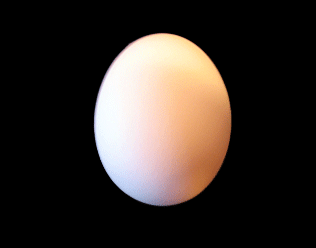
In days gone by the egg, due to its shape, was a symbol of the earth. Thanks to its obvious association with the beginning of life, it has also been the basis of many ancient creation stories. It has been a symbol of fertility, rebirth and the cycle of life. These latter symbols are so close to what Springtime is all about that it’s no wonder it’s been an important part of Spring celebrations since pre-Christian times.
As Europe became Christian, eggs became a symbol of Easter and the resurrection of Jesus. In the past, Christians gave up eggs for Lent (the 40 days before Easter when it’s customary to give up different types of food). But even though people didn’t eat them, the hens kept laying them! So people would hard boil and decorate them.
The egg is also part of the Jewish Passover holiday that takes place in the Spring. The egg is placed on the Seder plate and is a symbol of sacrifice and loss. Yet to some it also symbolizes the full cycle of life, and therefore hope and rebirth. (The egg is a more recent addition to the Seder plate compared to the other symbolic items that are found there and its symbolic meaning seems to be more open to interpretation.)
In China, red eggs are given out at the one month birthday of a new baby. It’s customary to hold a Red Egg and Ginger Party at this time. Once again, the source seems to be the egg’s role as a symbol of fertility and the beginning of life.
So here we come full circle (or oval) with the egg as a wonderful symbol of birth, renewal and rebirth. This is something wonderful to consider as Springtime approaches in the northern hemisphere, where the Earth will soon come back to life!
Feel free to let us know about any special symbolism of the egg in your culture in the comments below.
This article was posted on Saturday, February 23rd, 2008 at 4:22 pm and is filed under Austria, Belgium, Birth Customs, Bulgaria, China, Countries & Cultures, Customs and Traditions, Czech Republic, Denmark, Easter, Easter Eggs, England, France, Germany, Greece, Holidays Around the World, Hong Kong, Mama Lisa, Passover, Poland, Red Egg and Ginger Parties, Romania, Russia, Scotland, Seasonal, Seder, Slovakia, Slovenia, Spring, United Kingdom, USA, Wales. You can follow any responses to this entry through the RSS 2.0 feed. You can skip to the end and leave a response. Pinging is currently not allowed.

























March 21st, 2008 at 2:12 am
In hinduism the egg is symbol is related to the Lingam – the oval shape which si the formless shape of god. The lingam also represents light
April 10th, 2008 at 10:33 pm
Interesting story about the egg. I never knew this and now have something to tell the kids. Thanks for this.
April 3rd, 2009 at 4:06 am
Dear Mama Lisa,
You are so amazing! I wish I could see your face once!!! Who are you???? I guess you are dressed in white, you have wings like for Mother Goose and you are very nice….
one of your fan from Budapest
April 27th, 2011 at 10:29 am
Emanuela wrote from Italy:
Certo, mia cara. I pulcini e ogni cucciolo che esce dall’uovo richiama alla vita nuova. Anche per i cristiani é segno di Gesù che risorge dal sepolcro.
Of course, my dear. The chicks and every puppy that comes from the egg reminds us of new life. Even for Christians is a sign of Jesus who rises from the grave.
April 28th, 2011 at 11:46 am
Very good, Lisa.
April 30th, 2011 at 6:05 pm
Purabi wrote from Bangladesh:
Thanks Lisa for making me informed of so many new things about eggs. In our childhood when we used 2 go 2 visit our grandparents n other elderly relatives they would give us eggs as a symbol of love n affection. Those were not bought eggs, their own produced ones.
January 26th, 2017 at 11:52 pm
I Love It when I Come Across Stuff Like This
April 24th, 2018 at 7:21 pm
Here’s an interesting article I found about eggs from :The Girls Own Paper (1899):
EASTER EGGS.
In many European countries the egg is a prominent feature in the observance of Easter.
Many things indicate, however, that the Easter egg is older than that great Christian feast. It seems probable that the egg was dedicated to the goddess of Spring and played an important part in the heathen spring festivals.
Even to-day all sorts of curious superstitions attach themselves to eggs laid on Maundy Thursday [the Thursday before Easter]. They are supposed to protect those who eat them from all sorts of diseases, and it is firmly believed that if a shepherd buries the shells of one or more of these Maundy eggs in his pasture land, he will not lose a single sheep during the year following.
It is no doubt owing to the strong belief in their power of conferring benefits that we send eggs to our friends at Easter.
But long before the observance of Easter people wanted to improve upon the eggs as they came out of the nest, and proceeded to spend time and talent in colouring and beautifying their shells.
Originally Easter eggs were coloured red, which to our forefathers was a symbol of the rising sun.
Later, all possible colours were used for this purpose, and the eggs were adorned with coloured patterns, pictures and proverbs.
Here and there, especially in Austria, this custom still obtains, and in many of the villages and districts may be found skilled “Egg Painters,” who supply artistically-ornamented eggs at Easter.
The number of these artists is rapidly decreasing, for in modern times people, specially in towns, prefer to present their friends with eggs of chocolate and sugar. In Moravia [in the Czech Republic], among the German population in Iglau, the Easter egg still holds a very important place. Young and old present them one to the other, and young girls are allowed to give them to their sweethearts. A very interesting feature is that eggs are sent by those at home to their relatives in foreign lands. Great care is taken to have these beautifully painted or adorned with mottoes. There are skillful people in the surrounding district, who devote themselves to decorating and adorning with mottoes Easter eggs.
Franz Paul Piger, who has lately written a very interesting paper on Easter eggs for the Austrian folk, says that “the art of decorating Easter eggs is not so simple as one might think.” The artist first colours the egg yellow with the bark of apple trees which he has cooked in water; the part which is to remain yellow he covers with fine layers of wax, and then proceeds to cook it in water, with onion skins, which turns it red. This being done, he rubs the wax off and he has a yellow and red egg. Now he takes a sharp-pointed instrument and scratches his drawing on the egg-shell, which shines on the yellow or red ground in pure white. In this way he represents human figures, creatures and flowers.
The most important things on Easter eggs are the mottoes which are usually specially given by the person who orders the eggs. These mottoes are often full of sentiment, of expressions of love, friendship and good wishes; sometimes they are jests.
Not only are hens’ eggs used for this purpose, but those of geese also, which look more stately, and being larger admit of longer mottoes.
Men, women and girls also are occupied in ornamenting Easter eggs.
…Many of the Easter eggs are quite works of art in Moravia. There is a great variety of patterns, including geometrical figures, leaves, flowers, sprays, hearts, and stars.
The dark blue Easter eggs are especially beautiful covered with heart’s-ease…
…In Poland the women blow Easter eggs and cover them with coloured satin, after which they stick on them all sorts of threads and tinsel….
In Bohemia light-red eggs prevail, while in Salzburg Easter eggs resemble marble. It is only on close inspection that one discovers that the hens’’ eggs have received the veining by the most skillful and tender colouring.
The painting and other preparation of Easter eggs form quite an event in a country household, and here and there, especially in Hungary, the preparation is accompanied by national songs.
It is most amusing to note the care bestowed by the maidens on the eggs intended for the betrothed, the usual ornamentation being caressing doves and intertwined hands. If a Ruthenian youth receives from a girl an egg adorned with threads of wool he is thereby assured of her love and fidelity.
The same is the case in Carinthia and in the Rosenthal. Girls must present their lovers with at least two eggs adorned with inscriptions in order that there may be no doubt as to the firmness of their affection.
The artistic Easter egg, such as we have shown here, is gradually being set aside for eggs of chocolate and sweets, and the time will certainly come when, if we want to see artistic eggs, we must look for them in museums.
They will, we hope, for many years continue to appear in all their beauty at the sound of the Easter bells, be a proof of love and friendship, and awaken joy in many a heart, both abroad and at home.